Exploring the WTC Mall Slide: A Comprehensive Overview


Intro
The WTC Mall Slide in Dubai has quickly become more than just an attraction; it is a statement about how urban spaces can evolve. Nestled in the heart of Dubai's bustling shopping scene, this slide represents a synergy of architecture and design that beckons both thrill-seekers and casual mall-goers alike. As city living leans more towards experiential enjoyment, the slide embodies this shift by promoting physical activity, relaxation, and social interactions—all within the confines of modern commercial spaces.
Looking beyond the superficial excitement, the WTC Mall Slide serves as a catalyst for broader real estate trends in the city. It’s not just about a fun drop from one level to another; it’s about how unique features attract diverse crowds, shift investment dynamics, and redefine the essence of modern shopping and leisure. In essence, the slide becomes a microcosm of evolving consumer expectations in urban environments.
In the following sections, we’ll delve deeper into the market trends that surround the WTC Mall Slide, explore potential investment strategies related to innovative commercial features like this, and assess what all this means for stakeholders operating within Dubai’s unique real estate landscape.
Market Trends
Current Market Analysis
When one looks at the current market landscape in Dubai, it is evident that there is a burgeoning demand for properties that offer more than just utility. The WTC Mall Slide caters to a demographic that values experience and social influx. Property developers and investors alike are taking note: the incorporation of recreational elements adds significant value.
The rise of experiential retail has caused an upward tick in foot traffic in places like the WTC Mall. This isn’t merely a local trend; sectors globally are contemplating the benefits of design that enhances user engagement. Therefore, properties that integrate elements such as the WTC Mall Slide do not merely stand alone—they influence the broader dynamics of the market.
Future Projections
Moving forward, the investment community is left wondering: how do we align with these trends? If current preferences hint at a more immersive shopping experience that resonates with today's consumers, then projects that mimic the WTC slide's blend of architecture, leisure, and commerce may well see increased desirability.
Expect technology to play an increasing role in future projects. Imagine augmented reality extensions of slides or interactive play zones. All these innovations won’t just capture attention; they'll likely entice investment as stakeholders view such projects as prime candidates for appreciating value over time.
"Incorporating experiential features into commercial real estate is no longer a luxury; it has become a mantra for survival in a competitive market."
Investment Strategies
Types of Properties to Consider
For investors looking beyond traditional property types, various options arise. Consider:
- Mixed-use Developments: Properties that combine residential, commercial, and leisure spaces. These environments tend to attract diverse tenant bases, increasing the potential for positive cash flow.
- Experiential Real Estate: Spaces designed to deliver an experience, such as the WTC Mall Slide itself. Such properties stand to attract higher foot traffic and create a loyal customer base.
- Tech-Enabled Properties: Developments with integrated technology that enhances user experience can command higher rents and prices as consumer expectations rise.
Financing Options and Tips
Navigating the financial landscape for these innovative properties can be somewhat tricky. Here are some pointers:
- Research Grants and Incentives: The UAE government often offers incentives for developments that contribute to tourism and leisure, so it’s worth researching what’s available.
- Crowdfunding Platforms: New-age financing mechanisms such as crowdfunding are also making waves in real estate investment. They can provide access to funds that might not have been possible through traditional methods.
- Partnerships with Developers: Forming partnerships can dilute risk while enhancing the financial viability of your investment. Collaborating with developers who have a proven track record in experiential designs could greatly benefit your investment journey.
As we sift through the implications of features like the WTC Mall Slide, both current investors and potential buyers stand to gain valuable insights, paving the way for smarter investment decisions in an ever-evolving market.
Preamble to the WTC Mall Slide
The WTC Mall Slide holds a notable position in Dubai's contemporary urban landscape. This exhilerating structure isn’t just a slide; it’s a symbol of innovation that has taken the city’s architectural scene by storm. As visitors speed down this feature, they not only experience fun but also engage with a broader narrative of community interaction, commercial growth, and a shift towards experiential architecture.
The initial conception of the WTC Mall Slide arose from a desire to blend leisure with utility. The city wanted to attract visitors and locals alike, encouraging them to explore not only the slide but also the retail opportunities in the vicinity. Dubai is known for its ambitious projects, striving to push boundaries; the slide embodies this ethos, offering a playful yet sophisticated element that draws foot traffic.
By providing a rich thematic experience that marries playful design with highly functional commercial space, this slide has, in effect, changed the way developers and city planners approach public spaces.
Historical Context
The history of the WTC Mall Slide is entwined with the rapid developments witnessed in Dubai over the past two decades. Dubai's metamorphosis from a desert city to a global hub of trade and tourism saw the need for structures that tell a story and embody modern aspirations. Originally envisioned as a means to enhance the visitor experience in the retail sector, the slide has since become more than just a fun feature; it represents a cultural shift.
In recent years, urban designs in Dubai have increasingly focused on blending entertainment with everyday living. The WTC Mall Slide fits neatly into this context, appearing in a mall designed to be an all-encompassing lifestyle destination. When it opened, it was celebrated not only for its thrilling ride but also for its architectural ingenuity.
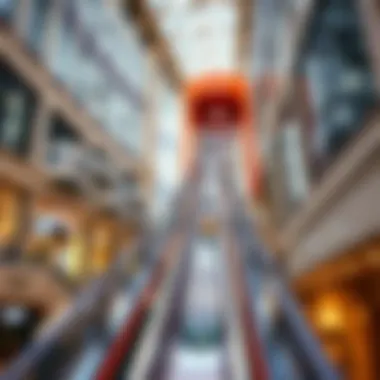
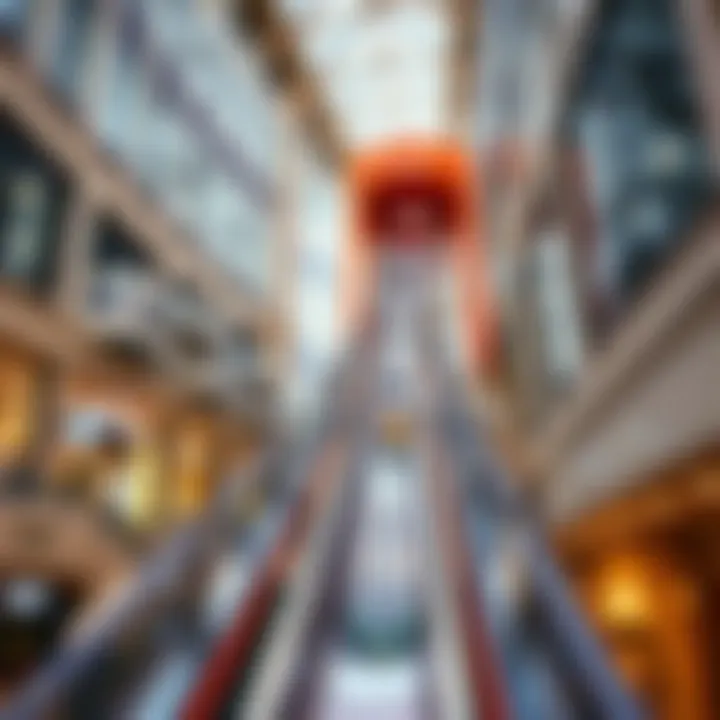
Significance in Dubai's Urban Landscape
The WTC Mall Slide is not just an architectural element; it’s a vital part of Dubai's evolving character. As cities around the world grapple with the challenges of urban design, the slide serves as an emblem of how entertainment venues can work to drive foot traffic and create more engaging urban experiences. By prioritizing high-impact design, it encourages visitors to linger, spend, and contribute economically to the surrounding area.
Undoubtedly, the slide influences broader discussions in urban planning and has elicited interest from investors looking for opportunities in emerging real estate markets. The emphasis on accessibility and enjoyment transforms a visit to the mall from a mundane shopping trip into an experience, emphasizing that urban landscapes can encourage community and interaction in dynamic new ways.
Structural Design of the Slide
The structural design of the WTC Mall Slide is not just a feat of engineering; it’s the backbone of what makes this attraction so memorable and intriguing. It serves as a pivotal element that intertwines creativity and functionality. This section will explore the various factors at play—from innovative engineering techniques that push boundaries, to carefully selected materials that ensure both durability and aesthetic appeal. These components are paramount not only for the slide's visual impact but also for its safety and commercial viability.
Innovative Engineering Techniques
The engineering behind the WTC Mall Slide incorporates state-of-the-art techniques that showcase ingenuity and foresight. One of the hallmark methods utilized is the use of parametric design software, allowing architects to conceive complex shapes and optimize them for structural integrity. This software helps in analyzing loads and stresses, ensuring the slide remains both safe and stable under varying conditions.
Another noteworthy engineering technique is the integration of modular construction principles. Pieces of the slide were pre-fabricated off-site, which streamlined assembly on location. This not only reduced time but also minimized disruption to regular mall operations—an essential consideration for commercial spaces.
Furthermore, the application of advanced fluid dynamics principles in design is critical as it dictates the slide's curvature and steepness. This ensures a thrilling yet safe experience for users, maintaining a fine balance between excitement and risk. The entire setup demonstrates a commitment to modern practices while addressing the unique challenges posed by urban environments.
Materials Used in Construction
Selecting the right materials is crucial when it comes to construction, especially for a structure like the slide. The WTC Mall Slide utilizes high-grade materials that contribute to both its durability and appearance. For instance, high-performance polycarbonate panels provide transparency, allowing onlookers to catch glimpses of the action from below, thus enhancing visual engagement.
Steel forms the structural skeleton of the slide, chosen for its strength and resilience. The combination of stainless and galvanized steel ensures protection against Dubai’s harsh climate and frequent use. Additionally, advances in anti-slip coatings applied to the surface of the slide cannot be overlooked. These coatings enhance safety, providing grip even in wet conditions, which ultimately contributes to user confidence when partaking in the slide experience.
Moreover, sustainable materials are also incorporated where feasible. For example, recycled rubber is used in the slide's padding areas, demonstrating a conscious effort toward environmental responsibility. This choice is not only beneficial for the planet but also resonates with a growing consumer preference for eco-friendly constructions.
User Experience and Accessibility
The WTC Mall Slide in Dubai is not just a feature meant for thrill-seekers; it plays a crucial role in enhancing overall user experience and accessibility within the mall. By focusing on these aspects, the slide integrates seamlessly into the environment and provides value to a broad range of visitors.
First and foremost, user experience is paramount in attracting both residents and tourists. The thrill of sliding down a structure that is visually appealing and strategically placed encourages a sense of adventure among users. This is particularly significant for families, who appreciate recreational spaces that cater to both children and adults. Merging excitement with safety gives parents peace of mind while their children indulge in play. Moreover, the positioning of the slide near dining and retail areas means that visitors can easily transition from thrilling activities to leisurely shopping or enjoying a meal. This flow enhances the overall ambiance of the mall, making it more inviting.
Accessibility is another cornerstone of the WTC Mall Slide's design. With Dubai being a melting pot of cultures, attracting diverse demographics, the slide is thoughtfully designed to accommodate a wide range of users, including those with disabilities. Ramps and designated entry points ensure that individuals with mobility challenges can partake in the experience without feeling left out. The increased focus on accessibility aligns with global standards and showcases the mall’s commitment to inclusivity. In today's urban design landscape, this consideration is not just advantageous but essential.
User experience and accessibility represent a dual approach; one that enhances joy and promotes inclusiveness. As the WTC Mall continues refining its offering, these elements are pivotal in shaping a positive perception among visitors. They create a space where everyone can enjoy themselves, building a sense of community.
Target Audience and Demographics
Diving deeper into target audience and demographics, understanding who frequents the WTC Mall Slide is crucial for tailoring marketing strategies and experiences. Primarily, the slide attracts expats, families, tourists, and young adults looking for engaging entertainment options. Each group brings unique needs and preferences, shaping how the slide is positioned within the mall's offerings.
The expat community comprises a significant portion of Dubai's population. Many of these individuals seek communal and family-friendly spaces that foster interaction. They are likely to bring children, which makes the slide appealing not just as an amusement feature but as a gathering point where families can connect and share experiences.
In contrast, tourists view the WTC Mall Slide as part of their exploration of Dubai—a city known for its boundary-pushing architecture and entertainment. For them, riding the slide can be a memorable, Instagrammable moment. They often seek unique experiences, and the slide stands out amid conventional tourist attractions.
Which leads us to young adults, who are generally drawn to novel experiences. The combination of speed, design, and social aspects positions the slide as an ideal spot for group outings. They are often influenced by trends seen on social media, making the slide a hotspot for sharing their adventures online.
Safety Features and Regulations
Safety features and regulations are non-negotiable when it comes to attractions like the WTC Mall Slide. The use of cutting-edge technology ensures that users can enjoy their experience with utmost confidence. From robust construction materials to detailed engineering, safety is built into every aspect of the slide’s design.
For starters, the slide is designed to accommodate a range of weight limits, ensuring that it is safe for almost every user. Each curve and drop has been meticulously calculated to minimize risk, while ample space around the slide allows for smooth movement in busy times.
- Regular maintenance checks are a staple to ensure that the slide remains in top condition. Signs indicating safety guidelines are strategically placed, providing clear instructions on how to use the slide properly—an essential feature for younger users or tourists unfamiliar with such attractions.
- Emergency protocols are well-established, with clearly defined procedures in case of any incidents. Staff trained in first aid are always on hand, taking an active role in monitoring the slide area, reinforcing a reassuring environment.
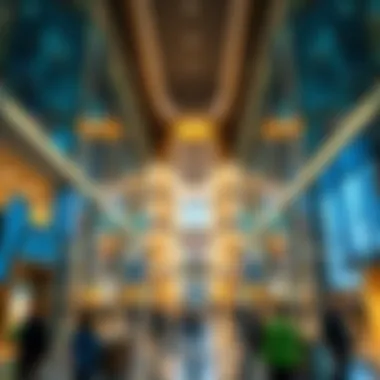
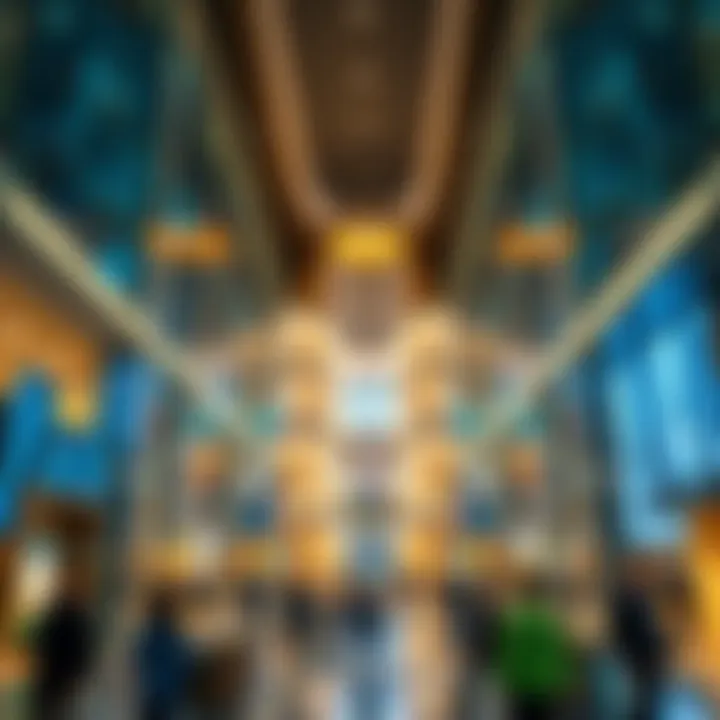
Influence on Local Real Estate Trends
Understanding the intricate link between the WTC Mall Slide and local real estate trends helps shed light on how modern architectural feats can alter market dynamics. The slide acts not just as an entertainment feature but as a catalyst for new investments, shifting perceptions of value in the area. In an era where buyers and investors are eager for unique selling points, the slide introduces an innovative element, enhancing overall desirability in the surrounding environment.
Attraction of Investors
The WTC Mall Slide has undeniably sparked interest among potential investors looking to tap into the burgeoning Dubai real estate scene. This fascination stems from various factors:
- Unique Offering: The slide possesses an allure that is hard to ignore. It’s not merely an addition to the mall but an experience that draws people from all over, both local and international.
- Increased Foot Traffic: With a notable attraction like the slide, the surrounding area sees a natural uptick in visitors, which piques investor interest. More people means more business opportunities for shops and eateries nearby.
- Fusion of Work and Play: Locations that encapsulate both lifestyle and leisure, like the WTC Mall with its slide, are garnering attention among younger buyers and expats looking for vibrant community hubs. This trend often translates to higher property values in the vicinity.
Additionally, the aesthetic and functional appeal of the slide enhances the area, making it a prime candidate for property development projects that seek to leverage this unique characteristic. Investors looking to maximize their returns are increasingly eyeing properties that relate directly to such attractions, marking a distinct shift in priorities when selecting investment opportunities.
Commercial Implications within WTC Mall
The commercial landscape within the WTC Mall has evolved significantly due to the presence of the slide. As more people flock to the area, retail spaces are experiencing the following impacts:
- Boosted Sales for Vendors: With a steady stream of customers drawn by the slide, retailers inside the mall can expect improved sales figures. This is particularly beneficial for small businesses that thrive on foot traffic.
- Potential for New Partnerships: Businesses are looking to collaborate on strategies that utilize the slide for marketing campaigns. For instance, launching seasonal events or promotions tied to the slide can attract more visitors to their stores.
- Attraction of National and International Brands: Given the increased visibility, many brands view spaces in WTC Mall as valuable opportunities. This influx can lead to a diversification of services and products available to consumers, effectively amplifying the mall’s market position.
Investors and business owners must navigate a rapidly evolving commercial ecosystem where the slide plays a central role in shaping consumer behavior and preferences. As the dynamics change, real estate professionals are advised to keep their fingers on the pulse of these trends to capitalize on emerging opportunities and foster growth in the area.
The presence of a novel attraction like the WTC Mall Slide can transform local real estate markets, creating ripple effects that benefit businesses and investors alike.
Comparative Analysis with Similar Structures
In today's fast-paced urban environments, the need for innovative architectural designs, like the WTC Mall Slide, cannot be understated. This section benchmards the slide against similar structures around the globe, examining both its uniqueness and its role within a broader context. By understanding the adaptive reuse of urban space and how it compares to other notable examples, stakeholders can draw valuable insights into urban planning and investment opportunities.
Benchmarking Against Global Examples
The WTC Mall Slide is not just a local attraction; it serves as a marker of Dubai's ambition to blend leisure with urban life. When compared to structures such as the Slide the City event that has graced various U.S. cities or the Vltava River Slide in Prague, it's clear that the WTC Mall Slide offers a new dimension to the conventional concept of recreational slides. Here are some global examples to ponder:
- Slide the City: This temporary slide creates excitement during summer events and pops up in various urban locales, transforming city streets into playgrounds. Yet its transient nature pales in comparison to the permanence and integrated design of the WTC Mall Slide.
- Vltava River Slide: A creatively designed, floating slide that attracts both residents and tourists along the riverbanks, offering a fun water activity. However, without the depth of commercial space associated with the WTC Mall, it lacks the multifaceted experience offered at this novel attraction.
- The Quay Slide in New Zealand: Known for its breathtaking views, this slide navigates a mountain landscape. While it provides thrill-seeking experiences, it's mainly oriented towards adventure tourism, missing the broader urban integration showcased by the WTC Mall Slide.
These examples reveal a growing trend of blending recreational features into urban landscapes, though many lack the continuous commercial viability that the WTC Mall Slide fosters.
Lessons Learned from Other Projects
In analyzing similar projects, several key takeaways emerge that can inform future developments. These experiences can guide the planning and execution of recreational elements in urban settings:
- Community Involvement: Engagement from local communities during planning phases proved crucial in ensuring acceptance and enthusiasm for slides elsewhere. The WTC Mall Slide, by involving local stakeholders in its concept, may have sidestepped potential pitfalls.
- Safety Regulations: Projects like Sliding into the Future in Sydney faced significant backlash due to safety concerns. The WTC Mall Slide's rigorous adherence to safety guidelines and regulations demonstrates the importance of prioritizing user safety, drawing on lessons learned from these missteps.
- Cultural Sensitivity: Cities that ignored their local culture faced difficulties. The WTC Mall Slide's soothing design complements Dubai’s architectural style, illustrating how incorporating cultural elements can enhance acceptance and visitor engagement.
- Diverse Use Cases: The success of recreational spaces often hinges on their ability to cater to various demographics. The WTC Mall Slide is designed not just for thrill-seekers but also for families and casual urban explorers, appealing to a wider audience.
By learning from these examples, future urban development projects can benefit tremendously—or perhaps avoid more than a few headaches.
"Innovative designs like the WTC Mall Slide not only entertain but redefine how we experience urban spaces, leaving lasting impressions on both visitors and investors alike."
As we move forward, it’s essential for investors, urban designers, and city planners to incorporate these lessons into forthcoming projects to ensure that they not only meet current trends but also anticipate future demands.
Community Engagement and Cultural Impact
The relevance of community engagement and cultural impact in the context of the WTC Mall Slide extends beyond mere architectural intrigue. It intertwines with the lived experiences of the people involved, threading through the fabric of the local society and economy. By examining these aspects, one can gauge the integration of the slide into the community's pulse and the environment it occupies.
Public Perception and Feedback
One cannot overlook how the public's perception significantly shapes the identity of a landmark like the WTC Mall Slide. Since its inception, this slide has been a focal point of discussion among both locals and expatriates. Collectively, they share their thoughts, experiences, and even critiques regarding this leisure feature.
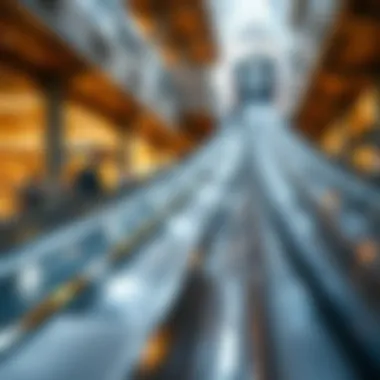

Feedback, often gathered from social media platforms such as Reddit and Facebook, showcases a mixed bag of sentiments. While many praise the attraction for its audacious design and sheer fun, others express concerns regarding safety measures or maintenance. This dichotomy illuminates the multifaceted nature of public engagement with modern structures. The dialogue surrounding the slide fosters a sense of belonging and ownership, where voices can influence future developments.
“Great spaces invite discussion as much as they invite people.”
In terms of feedback mechanisms, surveys and community meetings play a key role in shaping adjustments or enhancements to the structure. It’s not just about what architects envision; it’s about what the community desires. If the feedback loop is effective, the community feels seen and valued, enhancing public approval.
Impact on Local Businesses
The WTC Mall Slide doesn't only serve as a recreational venue, it serves as a catalyst for local businesses. A bright spot in Dubai's vast commercial landscape, this structure attracts throngs of visitors, driving foot traffic to nearby shops and eateries. Such an influx can dramatically alter the business landscape of the area, presenting opportunities for entrepreneurs eager to tap into this newfound customer base.
For instance, small cafes offering refreshments to slide-goers can thrive from the spillover of visitors looking for a place to relax after their slide experience. The rise in demand has prompted local vendors to tailor their offerings, leading to a richer, more diversified commercial experience within the mall.
Additionally, special events—like themed nights or community gatherings—can be organized in the vicinity of the slide, further solidifying its role as an entertainment hub. These events not only enhance community ties but also present marketing opportunities for businesses.
Like ripples in a pond, the impact of the WTC Mall Slide reaches far beyond its immediate vicinity. By intertwining recreational enjoyment with community and commercial development, it illustrates how modern urban spaces can elevate local culture and economic vitality.
Future Developments and Projections
The exploration of future developments and projections surrounding the WTC Mall Slide speaks volumes about the potential evolution of both the structure and the greater context of Dubai's urban landscape. Within this section, we will dissect key elements, benefits, and considerations regarding future projections, ensuring that investors, expats, agents, buyers, and renters grasp the full spectrum of implications tied to this unique architectural marvel.
Expected Trends in Urban Design
The urban design landscape is constantly shifting, driven by technological advancements, changing consumer preferences, and an ongoing push toward sustainability. As the WTC Mall Slide continues to capture the imagination of the public, it stands at the forefront of several trends that may shape future projects.
- Adaptive Reuse of Spaces: One noticeable trend is the adaptive reuse of existing structures. The WTC Mall Slide integrates seamlessly into the existing framework of the World Trade Center, offering a model for how urban planners can creatively repurpose spaces to enhance functionality and aesthetic appeal.
- Focus on Experience: Developers are increasingly prioritizing user experience over mere functionality. The WTC Mall Slide exemplifies this by marrying fun and engagement with convenience, providing a recreational space that enhances the overall shopping experience. Tomorrow’s urban landscapes will likely feature more attractions that cater to emotional and sensory experiences.
- Integration of Smart Technologies: Future developments will probably include greater incorporation of smart technologies, which are becoming integral to enhancing safety and promoting user comfort. For example, imagine an app that allows users to queue virtually before riding the slide or augmented reality features that enhance the experience as you slide down.
- Environmental Considerations: Sustainability is creeping into the fabric of urban design. Expect future developments related to the WTC Mall Slide to incorporate eco-friendly materials and techniques. This not only meets public demand but also aligns with Dubai’s vision of creating a more sustainable urban environment.
Long-Term Effects on Property Values
When examining the long-term effects that the WTC Mall Slide may impart on property values, it becomes clear that this structure is more than an attraction; it’s an investment catalyst. Over time, the presence of such innovative features influences real estate dynamics significantly.
- Increased Foot Traffic: One of the immediate outcomes is the potential for increased foot traffic in the area. More visitors to the WTC Mall equate to higher revenues for surrounding businesses. This uptick can lead landlords to hike rents, which may positively affect property values.
- Attracting Commercial Investment: Areas that feature unique and engaging attractions like the WTC Mall Slide often lure investors seeking opportunities in thriving locales. As demand for commercial space grows, so too do property values.
- Enhanced Community Appeal: The unique offerings within the WTC Mall, bolstered by the slide's presence, create a sense of community. Neighborhoods surrounding the mall will likely witness an increase in desirability, spurring property value enhancements as more people seek to reside close to such amenities.
- Long-Term Urban Revitalization: The addition of an attraction like the WTC Mall Slide can trigger urban renewal. As the area matures, older properties may be renovated or new developments may rise, driving property values up in the long run.
"The urban design elements set in motion by attractions like the WTC Mall Slide don't just enhance local commerce; they fundamentally reshape how we interact with our spaces."
In adapting to future trends and developments, the WTC Mall Slide positions itself not just as a fun experience but as a catalyst for economic and urban growth, making clear its role in the changing narrative of Dubai's real estate landscape. The unfolding story is one of potential—a narrative that will keep evolving as the WTC Mall Slide continues to influence how we think about urban spaces.
End and Final Thoughts
The WTC Mall Slide stands as a significant landmark within Dubai, showcasing not only architectural ingenuity but also its capacity to influence urban life in profound ways. This concluding section aims to encapsulate the essence of the slide and reflect upon the broader implications of its presence.
Summary of Key Insights
In examining the multifaceted nature of the WTC Mall Slide, several key takeaways emerge:
- Architectural Innovation: The slide is not merely a recreational feature; it is a testament to Dubai's commitment to blending fun with functionality in urban settings.
- Community Impact: Feedback from the public has indicated a largely positive reception, with many praising it as a vibrant addition to the local scene. This sentiment underscores the slide's role as a community hub.
- Real Estate Influence: The attraction generated by the slide is expected to have lasting impacts on local real estate values, drawing in new investments and elevating the desirability of the area for both locals and expatriates.
These insights not only highlight the slide’s direct benefits but also begin to frame a conversation about the future trajectory of similar endeavors in urban environments.
Reflections on the Role of Creativity in Real Estate
The integration of creative elements into real estate, as illustrated by the WTC Mall Slide, serves as a reminder of the critical importance of innovation in property development. Creativity in design can drive engagement and offer unique experiences that resonate with users. With evolving consumer expectations, properties that entertain as well as provide utility are likely to stand the test of time.
Moreover, as cities become more competitive in attracting both residents and tourists, the role of whimsical features like slides or parks cannot be overlooked.
"Creativity is the secret sauce for revitalizing urban spaces. A project like the WTC Mall Slide not only elevates the aesthetic appeal but also enhances the emotional connection between the space and its users."
In summary, the WTC Mall Slide exemplifies how integrating fun with structural purpose can profoundly shape a city’s narrative. It invites stakeholders in the real estate sector to rethink traditional notions of design and functionality. Investing in spaces that foster community interaction and engagement is not just a trend; it is a forward-thinking approach that could lead to greater longevity of developments.
As we look towards future projects, learning from the WTC Mall Slide could inspire a new wave of designs that marry creativity and practicality, benefiting urban landscapes and their inhabitants alike.



